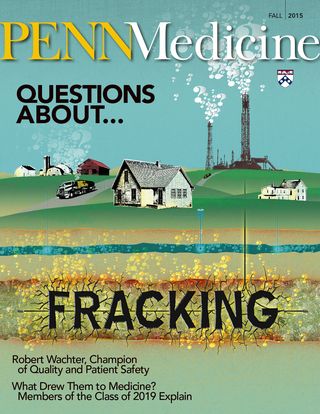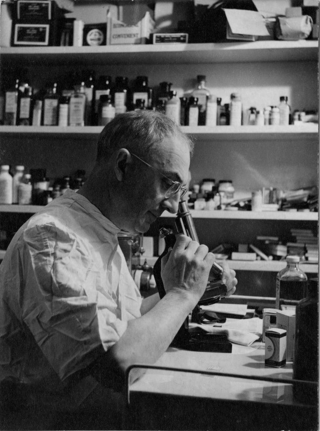 “Just a few years ago, the term fracking might have drawn a perplexed stare from most of the general population.” That’s how writer Mark Wolverton puts it in “Fracking and Public Health: Finding the Best Balance,” the cover story of the Fall 2015 issue of Penn Medicine. Perplexity is certainly no longer the case, particularly in Pennsylvania and other states like New York, Ohio, and West Virginia, that lie atop the Marcellus Shale formation. Indeed, for many people, fracking has become “a real and immediate curse word.” Why would hydraulic fracturing -- extracting natural gas from deep within the Earth by cracking open layers with high pressure liquids -- create such hostility? The main reason is that in the past, the process tended to be done in places where oil and gas drilling were well established. But now, for economic reasons, more drilling is being done in thousands of locations that have never seen anything comparable. Many local residents are not happy -- but even more, they often blame mysterious rashes and other ailments on the fracking.
“Just a few years ago, the term fracking might have drawn a perplexed stare from most of the general population.” That’s how writer Mark Wolverton puts it in “Fracking and Public Health: Finding the Best Balance,” the cover story of the Fall 2015 issue of Penn Medicine. Perplexity is certainly no longer the case, particularly in Pennsylvania and other states like New York, Ohio, and West Virginia, that lie atop the Marcellus Shale formation. Indeed, for many people, fracking has become “a real and immediate curse word.” Why would hydraulic fracturing -- extracting natural gas from deep within the Earth by cracking open layers with high pressure liquids -- create such hostility? The main reason is that in the past, the process tended to be done in places where oil and gas drilling were well established. But now, for economic reasons, more drilling is being done in thousands of locations that have never seen anything comparable. Many local residents are not happy -- but even more, they often blame mysterious rashes and other ailments on the fracking.
Enter Penn’s Center of Excellence in Environmental Toxicology (CEET). In cooperation with the Mailman School of Public Health at Columbian University, the center recently published a study that examined the association between what is termed “unconventional gas and oil drilling” and increased hospital utilization rates in the regions where the drilling took place. The study indeed found “significant” associations, which surprised the researchers. But as the study emphasizes, “the precise cause for the increase in patient prevalence rates . . . remains unknown.” That means further research is vital. Trevor Penning, PhD, the director of CEET, notes that what is needed is scrupulous scientific objectivity, especially in such a contentious situation. When the facts are clear, policy makers and industry leaders will likely respond accordingly.
Another story in the new issue of the magazine, a portrait of alumnus Robert M. Wachter, MD ’83, has its own share of controversy. Wachter, who received the Perelman School’s Distinguished Graduate Award in June, is a professor, editor, author, and blogger – but 20 years ago, he also was one of the leading advocates of a new specialty that appeared threatening to many physicians: the “hospitalist” track. The profile notes that when Wachter and his co-author, Lee Goldman, MD, MPH, published a seminal article in The New England Journal of Medicine, the response was immediate -- and sharply divided. Some primary-care physicians feared that patients would not want to be cared for by a physician they’d never seen, or they simply wanted to continue caring for their hospitalized patients. Over the years, however, the hospitalist movement has been hailed as the fastest-growing specialty in medical history. Wachter himself has ventured into other areas. His most recent book, The Digital Doctor: Hope, Hype, and Harm at the Dawn of Medicine’s Computer Age (2015), looks at both the advantages and problems -- and occasional controversies -- that come with advanced technology. In the end, Wachter writes in the book, “I am all for the wiring of health care.”
Another alumnus of the medical school, Greg Dunn, who earned his doctorate in neuroscience in 2011, provides some stunning images in the new issue of Penn Medicine. Our coverage was set in motion by Dunn’s exhibition at the Mütter Museum of the College of Physicians of Philadelphia, “Mind Illuminated,” which runs into January 2016. Prominently featured at the show are what Dunn calls microetchings, which attempt to suggest the brain’s immense complexity and constant activity. With the assistance of Brian Edwards, an artist and research scientist at Penn, Dunn etches on metal plates, making microscopic ridges at specific angles to catch light from different sources. Then the surface is covered with gold leaf. The result is that as viewers pass the image, it seems to have depth and the colors seem to change. In some of his earlier works, Dunn depicted neurons in the Asian sumi-e style, so that long dendritic trees looked uncannily like the “real” trees we see in nature. With microetching, he has continued to explore new forms, bringing together neuroscience and art.

William Carlos Williams, MD 1906
Shorter articles in the new issue are on Mously Le Blanc, MD ’06, who has found a niche at Penn Med providing care to cancer survivors, treating the late side effects of the therapies that cured them; and on the legacy of William Carlos Williams, MD 1906, who distinguished himself as both a physician and a poet. The issue’s longest article, however, is essentially about future alumni: members of the Class of 2019. It provides short portraits of nine representative students, drawn from the 156 who entered the Perelman School this fall. Among the new students are campus leaders in government, political organizations, and community groups. Many were varsity athletes, in sports ranging from soccer, football, and lacrosse to saber and gymnastics. Many have shown talent in diverse artistic and musical fields. Continuing a recent trend, many in the class took a year or more off after college to pursue a variety of experiences. Some worked at the National Institutes of Health or at top academic health centers; others worked in pharmaceutical and biotech industries. Significantly, most of the students have been extensively involved in community service both in the U.S. and abroad.
But as I discovered in interviewing the nine students, their backgrounds ranged widely -- and they’ve brought these diverse experiences into their quest to become doctors. Claire Hirschmann, for example, was a founder of a traveling high-school program in Maine that combines academics and place-based education. Mariah Owusu-Agyei came to the United States with her family from Ghana and worked for a time as a financial analyst with Citigroup before deciding to enter medical school. David Steinmetz was a disk jockey for the University’s student-run radio station, specializing in live recordings of the Grateful Dead.
Read more online in the digital edition of Penn Medicine.